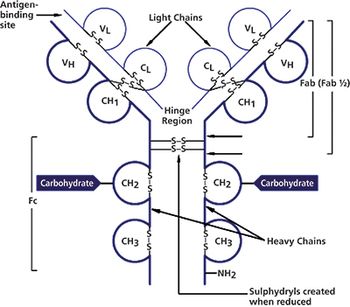
The biopharmaceutical industry continues to focus on the development of biotherapeutic monoclonal antibody (mAbs) drugs. In this article, the compatibility of SEC coupled with HRAM–MS for the analysis of mAbs is demonstrated.
Dionex Corporation

The biopharmaceutical industry continues to focus on the development of biotherapeutic monoclonal antibody (mAbs) drugs. In this article, the compatibility of SEC coupled with HRAM–MS for the analysis of mAbs is demonstrated.
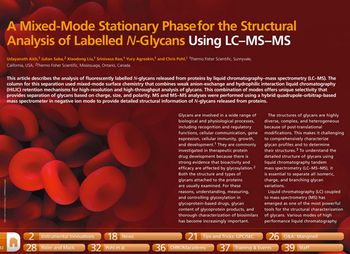
This article describes the analysis of fluorescently labelled N-glycans released from proteins by liquid chromatography–mass spectrometry (LC–MS).
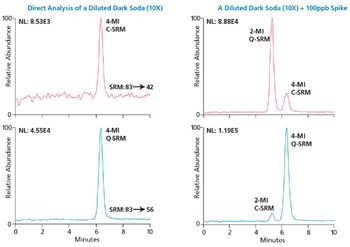
The chemicals 2- and 4-methylimidazole (2-MI and 4-MI) are by-products produced during the manufacturing of caramel coloring ingredients used to darken food products such as carbonated beverages and soy sauce.
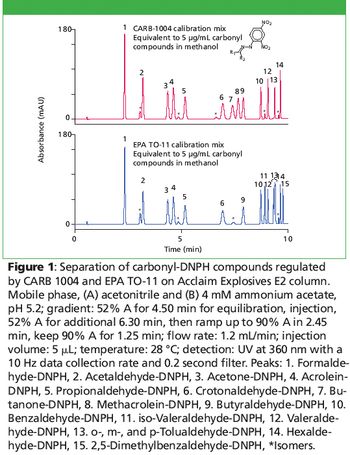
Carbonyl compounds, including low molecular weight aldehydes and ketones, have environmental and health concerns; for example, short-term exposure to aldehydes can irritate the eyes, skin, and upper respiratory tract. Motor vehicles emit reactive hydrocarbons that undergo photochemical oxidation in the atmosphere, which generates formaldehyde and other carbonyls. In addition, formaldehyde contributes to the formation of photochemical ozone. California Air Resources Board (CARB) Method 1004 (1) provides an analytical method for the automotive industry to monitor 13 carbonyl compounds in engine exhaust. US EPA Method TO-11A (2) and Method 8315 (3) monitor atmospheric formaldehyde and 14 other carbonyl compounds and are used for a variety of environmental and occupational health purposes. In these methods, carbonyl compounds are trapped as the dinitrophenylhydrazine (DNPH) derivatives before analysis by HPLC.
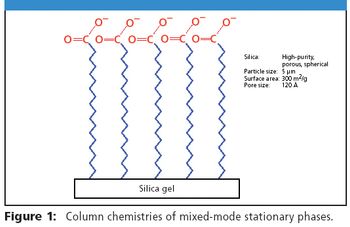
The separation and quantitation of drug substances and counterions are two important determinations in the pharmaceutical industry (1). Drug substances and counterions are determined by HPLC (often on reversed-phase columns) and by ion chromatography (IC), respectively. IC is the preferred method for selective and sensitive screening of both cationic and anionic pharmaceutical counterions (2). To increase the analysis throughput, it is desirable that for analysis of drug formulation both drug substance and counterions can be determined within a single run. Naproxen is a non-steroidal anti-inflammatory drug commonly used for treating moderate to severe pain, fever, inflammation, and stiffness. Naproxen sodium was approved by the U.S. Food and Drug Administration (FDA) as an over-the-counter drug. No reports were found describing one technique for the simultaneous determinations of both naproxen and the counterion (Na+).

The recent development of ultra-HPLC (UHPLC) has provided a great potential for high throughput analysis achieved using small (sub-2 μm) particle size columns at increased linear velocities. The advantage of UHPLC over conventional HPLC is increased throughput without sacrificing resolution. Despite their popularity, sub-2 μm particle columns impose practical difficulties, such as high backpressure (which often requires a UHPLC system) and susceptibility to column fouling. Thus difficulty can be overcome using 2.0 to 2.5 μm particles. This study describes an example (analysis of vanilla extract) of transferring a conventional LC method to a high-throughput method using newly developed Acclaim® RSLC 2-μm columns that are based on spherical, porous, high-purity silica particles (dp = 2 μm, pore size = 120 Å, surface area = 320 m2/g).


Published: December 11th 2013 | Updated:
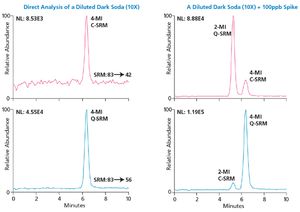
Published: June 1st 2011 | Updated:

Published: February 1st 2009 | Updated:

Published: February 1st 2008 | Updated:
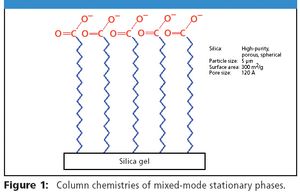
Published: September 1st 2008 | Updated:

Published: September 1st 2008 | Updated: